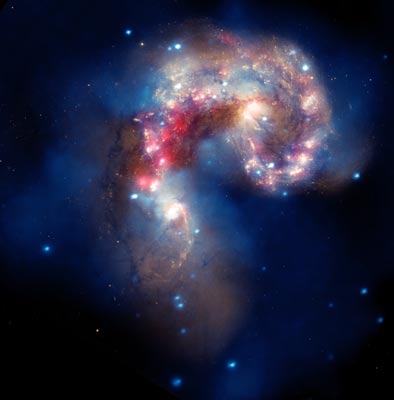Galaxy Formation & Evolution
Tracing the assembly history of galaxies over cosmic time is a foremost goal in the exploration of the Universe. Indeed, galaxies are the building blocks of the Universe. They are the cradles for the formation of stars and black holes, but also serve as beacons that allow us to probe the geometry of space-time, the nature of dark matter and dark energy.
The field of galaxy formation and evolution concentrates on unveiling the origin of systems such as our Galaxy, the Milky Way, and the very wide diversity of the general galaxy population.
LASTRO particularly focuses on three aspects:
1) the conditions of formation and nature of the first stars, 300-500 Myr after the Big Bang
2) the assembly of galaxies, from the first systems (dwarf-like) to more massive ones
3) the coeval evolution of cosmic large scale structures and galaxies, and how, in this context, star formation is fuelled or quenched.

The Antennae galaxies, located about 62 million light-years from Earth, are shown in this composite image from the Chandra X-ray Observatory (blue), the Hubble Space Telescope (gold and brown), and the Spitzer Space Telescope (red). The Antennae galaxies take their name from the long antenna-like "arms," seen in wide-angle views of the system. These features were produced by tidal forces generated in the collision. The collision, which began more than 100 million years ago and is still occurring, has triggered the formation of millions of stars in clouds of dust and gas in the galaxies. The most massive of these young stars have already sped through their evolution in a few million years and exploded as supernovas. Credits: NASA, ESA, SAO, CXC, JPL-Caltech, and STScI Acknowledgment: J. DePasquale (Harvard-Smithsonian CfA), and B. Whitmore